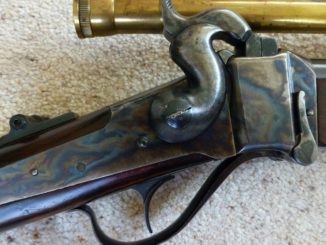
Introduction
During the first half of the 19th century great leaps forward were made in firearms technology and by the 1870s soldiers who 50 years earlier would have been supplied with flintlock, smoothbore muskets were being equipped with devastatingly effective, single-shot cartridge rifles such as the formidable .577/450 Martini-Henry. The big problem that still had to be overcome though was rate of fire. Muzzle loading percussion rifles, such as the Pattern 1853 Enfield rifle that fired the deadly Minié ball, could in the hands of a trained man get off three rounds per minute and this went up to around 10 rounds per minute with the breech loading Martini-Henry that fired self-contained metal cartridges.
Experience in the field, however, soon taught the British Army that troops armed with single-shot rifles however powerful could still be defeated by overwhelming numbers of fanatical opponents armed only with the most basic of stabbing weapons. What was needed to ensure that our forces prevailed around the world was a simple, reliable yet powerful repeating magazine rifle capable of a much higher rate of accurate, aimed fire. At the time there was nevertheless some opposition to putting repeating weapons into the hands of ordinary infantrymen as many senior military officers felt they would simply fire off their ammunition wildly and to little effect when under the stress of battle.
Early attempts by Samuel Colt to produce repeating rifles using a revolving cylinder had not met with much success due to their inherent danger to the hands of the user. The development of the self-contained metallic cartridge made the repeater a viable proposition and by the 1860s two tubular magazine rifles, the Spencer and the Henry were developed in time to see action in the American Civil War.
Early Tubular Magazine Rifles
Although metallic cartridges were available in the 1860s, they were still in their infancy and their design did not always lend itself to magazine loading as only ‘pinfire’ and ‘rimfire’ ammunition was available. Pinfire cartridges have a protruding pin which has to be located in a notch in the chamber and this is hit by the descending hammer driving it into the internal cap setting off the charge. Rimfire is the system still used on modern .22 and .17HMR ammunition which has its priming compound contained within the rim of the cartridge. The firing pin of the weapon crushes the soft metal rim to initiate the explosion of the round.
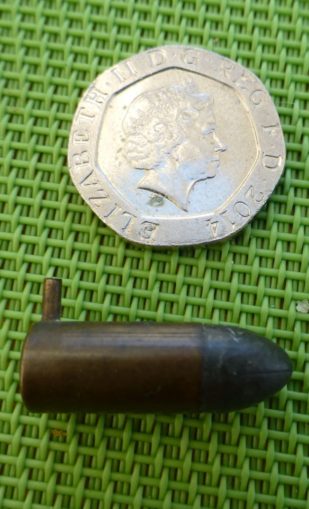
Clearly, pinfire ammunition that is prone to being set off by accidental contact with the pin, could not be used in magazines while rimfire cartridges, which at the time were made from soft copper sheet, could not withstand high pressures and were therefore limited to relatively low-powered loads. Simply using thicker copper in their construction was not an option as this made the rims too thick to be crushed effectively by a firing pin or hammer. For this reason the Spencer and the Henry used only low-powered pistol ammunition.
1. The Spencer Rifle 1860-1869

Hmaag [CC BY-SA 3.0], via Wikimedia Commons
As rimfire ammunition is no longer manufactured other than in miniature calibres and cannot in any case be reloaded, anyone wishing to shoot an original Spencer must first have it modified to accept modern centrefire ammunition.
2. The Henry Rifle 1860-1866

National Museum of American History [Public domain], via Wikimedia Commons
The Henry was chambered in .44 rimfire using 30 grains of black powder (which, as you may recall, is the same as the 1860 Colt ‘Army’ revolver and half that of the 1847 Colt Walker revolver) so again it was low-powered. The rifle had a long tube fitted under its barrel into which 15 cartridges could be loaded base first with one in the breech making it a 16-shot repeater. According to popular myth it was known as ‘the rifle you load on Sunday and shoot all week.’ The Henry was loaded by pushing a tab that protruded from the slot in the tubular magazine up to the muzzle to compress the spring and then pivoting the end of the magazine to one side to allow the cartridges to be dropped into the tube. The magazine ‘follower’ was then pivoted back into place so that the spring could push the rounds towards the action as the mechanism was operated.
The Henry rifle had a faster rate of fire than the Spencer as operating the lever cocked the hammer, extracted and ejected the spent case and lifted and chambered another cartridge ready to be fired. The Henry rifle had its problems though as the open slot in the magazine was liable to collect dirt and grit and as there was no wooden fore end it was uncomfortable to hold especially when hot from sustained fire. Modern reproduction Henry rifles are chambered in 44-40 centrefire and must be loaded with flat nosed bullets to prevent rounds going off while being loaded. I know of one incident where this happened due to the owner’s mistaken use of pointed bullets and the magazine follower being accidently knocked sideways while loading. A round went off in the tube but amazingly no one was injured and surprisingly little damage was done to the rifle.
3. The Winchester Rifle 1866 – present day

Antique Military Rifles [CC BY-SA 2.0], via Wikimedia Commons
40,000 Model 1866 Winchesters and four million cartridges were supplied to the Turkish government and used to good effect against charging Russians in the Russo-Turkish War of 1877-78 but they were of limited use on the battlefield where there was a need for collective fire at ranges in excess of 1000 yards.
The Box Magazine Rifle
Although other European countries adopted tubular magazine rifles – Switzerland (Vetterli), Austria (Kropatschek), France (Lebel) and Germany (Mauser) – the British were content to wait for a better solution to be found. This came about in 1879 when James Paris Lee, a Scottish-born Canadian, patented a bolt-action rifle with a box magazine that was to influence the design of our service rifles for 75 years, until well after the end of the Second World War.
The Small Arms Committee set up in 1884 had been instructed to report on the magazine rifle and had decided that such an arm was essential for morale in case British soldiers should ever face them in the hands of our enemies.
The .303 Lee-Metford Cavalry Carbine 1895

In 1888 after successful trials by troops throughout the Empire, the Lee-Metford rifle was officially approved for manufacture and was called the Magazine Rifle Mark I. It incorporated an eight-round magazine attached to the rifle by a chain link and had a safety catch that prevented the bolt from being opened when engaged in the half-cock position. This was an improvement on the Martini-Henry that had no safety device fitted.
The rimmed MkI cartridge was centrefire, of drawn brass construction and bottle-necked. It used a compressed and shaped black powder charge of 71.5 grains to drive a 215 grain bullet at around 1850 feet per second.

In the case of the Cavalry Carbine version, six cartridges were loaded into the magazine through the top of the action body with the bolt fully drawn back and the magazine cut-off (a pivoted plate that prevented cartridges from being fed from the magazine) open. The cut-off was then closed and a further cartridge could be loaded into the chamber with the bolt safety catch on to prevent accidental discharge. The idea was that troopers would use their rifles in single-shot mode while their enemy was advancing before opening the magazine cut-off to permit rapid fire when they were at closer range.


The markings on the side of the action on Lee-Metford Cavalry Carbines are at the top as originally, a saddle D-ring was fitted so that it could be attached to the saddle by a lanyard in case it was accidentally dropped. It can be seen that this carbine was modified in 1896 to grind off the saddle ring; in 1897 to fit screws and a leather sight protector; in 1898 to remove the screws and sight protector and in 1899 to remove the fluted-tipped cleaning rod that was originally supplied. I should add that I have since re-fitted a pair of original sight protector screws and a homemade leather sight protector together with a cleaning rod that a gunsmith friend amazingly ‘just happened to have lying around.’
The rifle that I am using to illustrate this section is the rarest and most valuable item in my modest collection. Carbine (shorter barrelled) versions of infantry rifles were provided for the use of mounted troops as they were easier to handle on horseback and could be carried in a leather ‘bucket’ attached to the saddle. The Magazine Lee-Metford Cavalry Carbine MkI was only produced in 1895 before being replaced by the Magazine Lee-Enfield Cavalry Carbine MkI in 1896 for reasons that will be explained later. That my carbine has survived in its original state is quite amazing and difficult to understand as it definitely underwent armoury modifications as late as 1899 yet still retains its original Metford barrel.
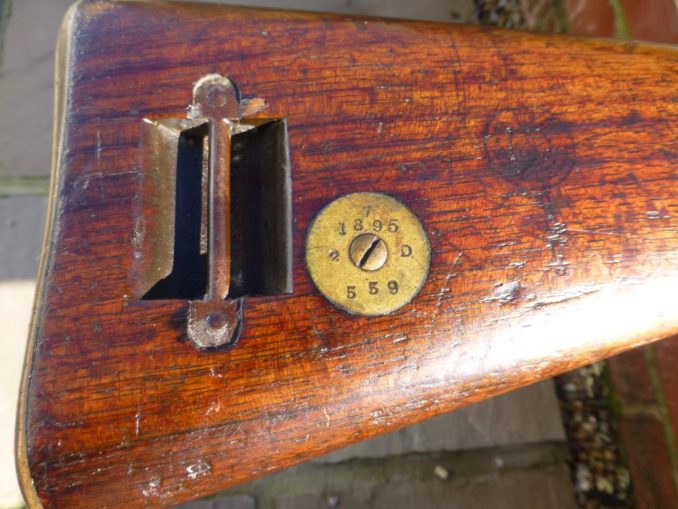
The provenance of this carbine is confirmed by the stampings on the stock disc which shows that it was issued in July 1895 to the Second Dragoons (2D) otherwise known as The Royal Scots Greys. 559 is the ‘rack number’ but unfortunately no records were kept of the individuals to whom the carbines were issued.
When I was in Edinburgh a couple of years ago, I took a picture of the fine equestrian statue erected in 1906 in memory of the Royal Scots Greys who gave their lives in South Africa in the Boer War of 1899-1902. I was pleased to see that it faithfully depicts the trooper’s 1895 Lee-Metford Cavalry Carbine and saddle bucket.

My carbine which has South African serial numbers engraved into the action and barrel and was returned to the UK sometime in the 1990s must have been a Boer capture. It is sobering to think that it may well have been carried into battle by one of the troopers who was killed in action and is commemorated by the memorial.
Smokeless Powder and the Full Metal Jacket
The next milestone that was as significant to firearms development as the percussion cap was smokeless nitro-cellulose propellant. Between 1882 and 1884, the French chemist Paul Vieille perfected the first smokeless powder which the French government referred to as ‘Poudre B’ or ‘Poudre Blanche’ (White Powder) so as to confuse German spies. The new propellant, which was three times as powerful as black powder weight for weight, had a number of advantages over the black powder that it replaced. Firstly it did not generate huge clouds of smoke to obliterate the target and give away troop positions; second it gave a higher muzzle velocity and so shot flatter and to a greater range; third it did not produce copious amounts of fouling in the barrel and action and fourth, it allowed the use of smaller diameter, lighter bullets so more ammunition could be carried by each soldier.
As the muzzle velocities of smaller bore rifles had risen, lead bullets had been found to partially melt due to the hot gases and friction with the rifling which led to the deposition of lead onto the internal barrel surfaces. This had an adverse effect on accuracy and was difficult to remove. One solution, used in Martini-Henry ammunition, had been to wrap hardened lead bullets in paper jackets that prevented the bullets’ walls from coming into contact with the rifling but in 1882 these were made obsolete when Lieutenant-Colonel Eduard Rubin of the Swiss Army Laboratory invented the copper-jacketed lead bullet.
These copper jackets that completely enclosed the lead core permitted much higher muzzle velocities to be achieved with smaller calibre, more aerodynamic, pointed or ‘Spitzer’ bullets that flew farther, more accurately and with greater energy.
In its turn the British Government Laboratories produced their own nitro-glycerine based propellant that was formed into long strands and known as ‘Cordite’. In 1892 Cordite was used together with a cupro-nickel jacketed, round nosed bullet in the .303 cartridge giving a muzzle velocity of 2060 fps. Unfortunately, Cordite burned much hotter than black powder and rapidly eroded the very shallow rifling of the Metford barrel that had originally been designed for use with black powder and hardened lead projectiles. This necessitated recalling Lee-Metford rifles to have them re-barrelled with the newly developed Enfield rifling that was deeper and square cut.
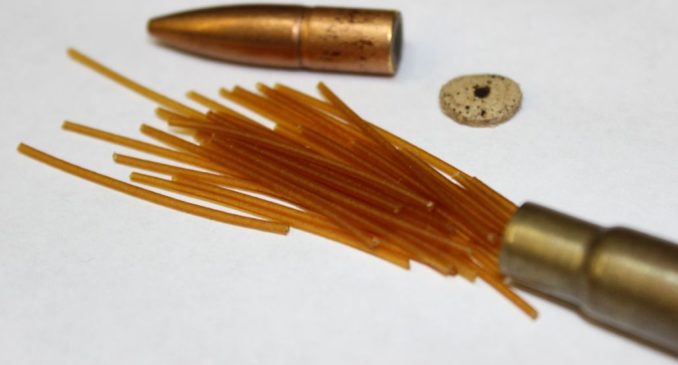
The .303 British cartridge in its original Mark I form propelled a 220 grain lead bullet at around 1850fps. By the outbreak of The Great War in 1914 the Mark VII cartridge utilising tubular cordite and a fully metal jacketed 174 grain spitzer bullet achieved a much more potent 2,440fps. The only other significant change to the .303 British cartridge was approved in 1938 when Cordite was replaced by a cooler burning nitro-cellulose granular powder and a more aerodynamic, boat-tailed bullet better suited to long-range machine gun fire was introduced.
The .303 Magazine Lee-Enfield Rifle 1895-1907

Known affectionately as the ‘Long Lee’ or ‘Long Tom’, the Magazine Lee-Enfield was the standard British infantry rifle during the Boer War although this particular example, which is exactly the same as the military version but without the military stampings and inspection marks, was a private purchase from BSA that would have been used in civilian marksmanship competitions. Firearms legislation was much less strict at the turn of the 20th century and private citizens could purchase the latest military specification rifles with the minimum of formality. The BSA Rifles and Rifle Sights Catalogue 1912 contained the following statement under the heading ‘Lee-Enfield Magazine Rifles’:
‘A CONDITION OF SALE MADE BY THE WAR OFFICE AUTHORITIES is that these RIFLES (except when fitted with miniature or mid-range barrels) SHALL BE SOLD TO BRITISH SUBJECTS ONLY. Forms of guarantee are supplied on request, to be signed by the buyer and sent with order.’
How times have changed.
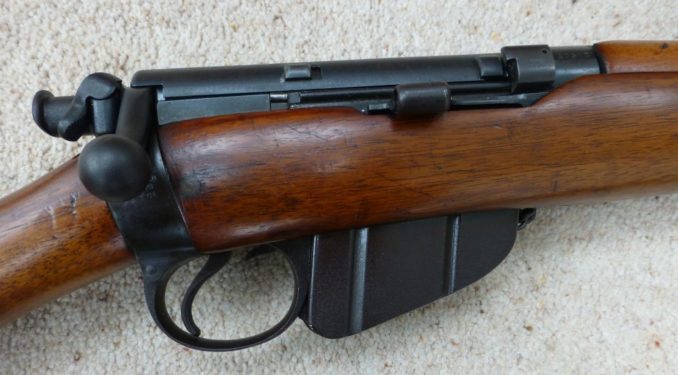
Lee-Enfield magazines were designed to be loaded with them in place in the rifle with the magazine cut-off open. They were normally only removed for cleaning.
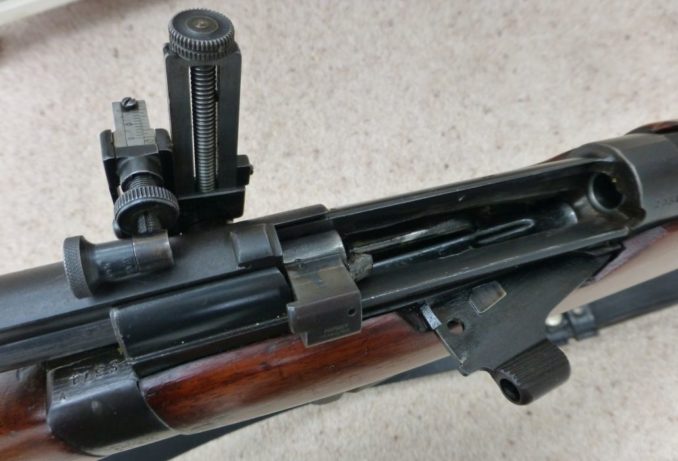
When the bolt is pushed forward, it picks up a cartridge from the magazine and slides it into the chamber. With the bolt locked in place, the rifle can be fired and when the bolt is opened it re cocks the action, extracts and ejects the spent case ready for another round to be chambered. It is a very fast, smooth and reliable action.
When I first bought this rifle I was very disappointed that it shot well to the left using the original open sights that are not adjustable for ‘windage’ or horizontal movement. To my surprise I later learned that this was a problem that had been experienced by our troops when they first went out to South Africa necessitating the recall of the rifles so that sight modifications could be carried out. As my rifle was as originally supplied, I decided to fit a period BSA 9c (1912) pattern target aperture sight that immediately transformed it into a tack-driver. It is now the most accurate Lee-Enfield that I have ever encountered.
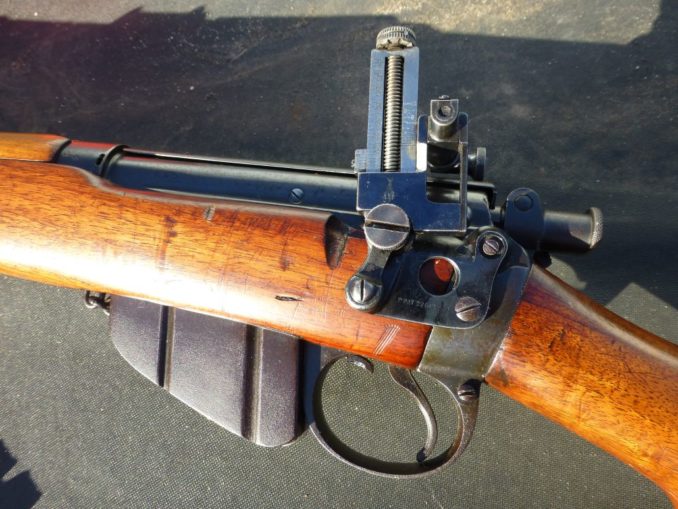
One other peculiarity of these early rifles that was retained on its successors until 1916 was the ‘volley sight’ that allowed collective harassing fire at targets beyond the range of direct fire. The sight comprised two elements, an aperture on the end of a fold away rod that the shooter peeped through (removed from my rifle in order to fit the target sight) and another rod-mounted bead on the fore stock that was adjustable for ranges of up to 2,800 yards. In practice, the platoon would sight onto, say, a distant gun crew and all fire together at a high angle in order to rain bullets onto the enemy distracting them from their task. How effective this was is a moot point as machine guns were later used for this purpose.

If you would like to see a film that features the Long Lee in action, I would suggest ‘Breaker Morant’ (1980) starring Edward Woodhead, Bryan Brown and Lewis Fitz-Gerald as three lieutenants in the Australian Bushveldt Carbineers during the Boer War. It’s one of my all-time favourites and is based on a true story.
Reloading the .303 British Cartridge
When compared with loading black powder cartridges, loading smokeless ammunition is much quicker and simpler. Fired cases are usually cleaned in a vibrating tumbler before being de-capped and sized in a die. Because of the higher chamber pressures generated, cases are then checked for length and trimmed to the correct dimensions before being primed. Smokeless powder is metered in a semi-rotary powder measure within precise safety limits set by the powder manufacturer, poured into the case and topped off with a bullet seated to the correct depth with a seating die. There is no need for lubricant, wads or fillers as is the case with black powder so the process can easily be automated for volume factory production.
Portents of the Future
Anyone who has ever fired a powerful pistol, rifle or shotgun will be aware that, in accordance with Newton’s Third Law of Motion, they recoil or ‘kick’ often viciously. Towards the end of the century great progress was being made to utilise this otherwise wasted energy to cycle the mechanism of the weapon so that every time the trigger was pulled, the gun would reload and fire until its magazine was empty.
In 1896 Mauser produced their C96 semi-automatic pistol and it was a ‘Broomhandle’ Mauser that Winston Churchill was carrying when he was captured by Boers in 1899 when a troop train he was travelling on was ambushed. Fortunately for him, he managed to dump the two magazines of dum-dum bullets that he was carrying for had they been found in his possession he would have been executed by his captors as a war criminal. This is one pistol that I would love to own but post-Dunblane that is not possible in the UK and I have to be satisfied with a CO2 powered replica that shoots .177 steel ball bearings.
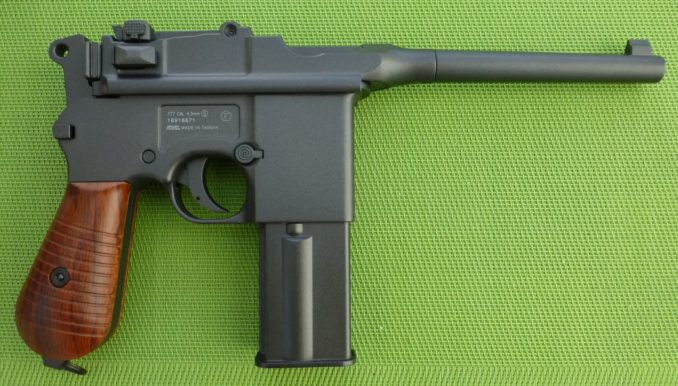
In 1884, the first fully-automatic, belt-fed, recoil-operated machine gun was invented by Sir Hiram Maxim, a development that made cavalry charges pointless and frontal assaults on fortified positions all but suicidal.
By the end of the 19th century the scene had been well and truly set for the imminent industrial scale slaughter of combatants that came to be known as The Great War.
Conclusions
When I started this series of articles, my brief was to look at selected developments in firearms technology during the 19th century with reference mainly to pistols and rifles in my own limited collection or owned by my shooting friends. Rather than being an in-depth analysis, it has of necessity been superficial and subjective but also, I hope, interesting and entertaining.
In this gallop through the century of change, I have come to realise that the most significant factors that influenced the development of firearms were those affecting ammunition. The percussion cap (1820s) ended two hundred years of flint ignition and paved the way for practical repeating weapons; the drawn brass centrefire cartridge (1870s) made breech loading, high-powered, magazine weapons practicable and smokeless powder together with the full copper jacket (1880s) enabled the development of higher velocity, smaller bore ammunition.
At the start of the 19th century, only carefully selected members of our armed forces were considered suitable to be issued with rifled flintlocks accurate to about 300 yards and capable of two or three shots per minute. A hundred years later common infantrymen were marching into battle in South Africa armed with bolt-action magazine rifles sighted to over 1000 yards and capable, in the hands of a skilled rifleman, of 30 aimed shots per minute. Such is progress.
Sadly, despite their excellent new rifles, our troops were destined to suffer badly when facing Boer farmers whose ability to feed their families often depended upon their prowess with a rifle. In the hands of a typical Boer, a modern military rifle like their preferred 1895 Mauser 7x57mm, was deadly even at very long ranges and dealing with effective guerrilla fighters armed with modern weapons was a totally different prospect from mowing down massed tribesman armed with spears.

The hard lessons learned by our forces in the Boer War eventually led to a government initiative aimed at encouraging ordinary British civilians to learn the principles and practice of marksmanship in case of future conflict. There was also a call for the development of a new, more powerful cartridge and rifle to replace the Lee-Enfield – but that, as they say, is another story.
© Tom Pudding 2019
Audio file


